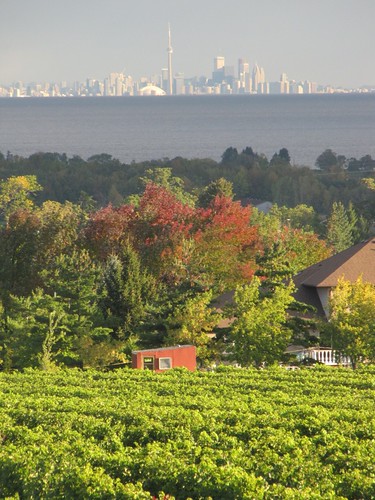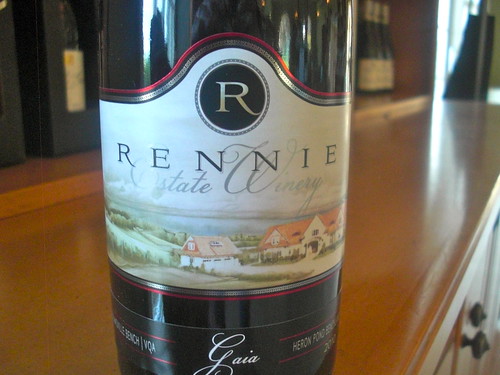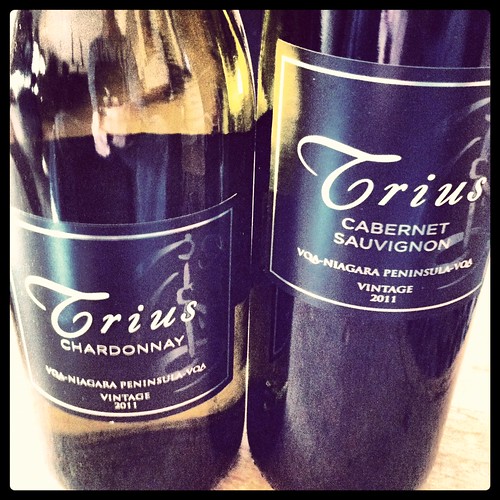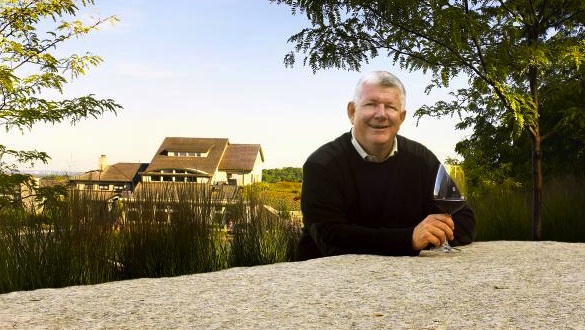
For Graham Rennie, a Beamsville Bench grape grower and now winemaker, the key to combating the wildly fluctuating seasons in Niagara is to utilize an old trick traditionally used for the production of Amarone, a richly flavoured Italian wine.
Rennie’s estate consists 44 acres of planted fruit including top-quality Chardonnay, Pinot Noir, Cabernet Sauvignon, Cabernet Franc and Merlot from the Mercier nursery in France.
The vineyard was planted in the spring of 1999 with spacing at 1,275 vines per acre with eight-foot-wide rows. The varietal mix is 28% Pinot Noir, 17% Chardonnay, 20% Merlot, 20% Cabernet Franc and 15% Cabernet Sauvignon.
 Rennie has sold all his grapes for Jackson-Triggs’ and Inniskillin’s top bottlings, but recently decided to keep a small parcel of grapes to make a Chardonnay, Pinot Noir and appassimento-Bordeaux varietals under his own label.
Rennie has sold all his grapes for Jackson-Triggs’ and Inniskillin’s top bottlings, but recently decided to keep a small parcel of grapes to make a Chardonnay, Pinot Noir and appassimento-Bordeaux varietals under his own label.
His main concern was standing out in an already crowded market. “I want to make wine, but does Ontario need another Pinot Noir or Chardonnay,” he asked me earlier this year.
A tough question, since the Rennie Vineyard grows some pretty exciting Chardonnay and Pinot Noir right out of the gate and both those varieties figure strongly into his portfolio. But he wanted something else, something unique and something that would showcase his Bordeaux varietals.
The solution to Rennie’s own question was found 6,800 kilometres away in Verona, Italy, where he was smitten by the appassimento style of wines being made in Valpolicella.
Grapes there are dried after harvesting for up to 120 days to add complexity and structure to the wines.

“The process makes so much sense to me,” said Graham recently, especially in Niagara where the big red varieties are susceptible to vintage variation. So he set about experimenting with his own Cabernet Franc. In 2009 he harvested a ton of it and used a greenhouse to the dry the grapes. The grapes were harvested at 22.5 brix and dried to 29 brix before pressing.
It was modelled after a traditionally-made Amarone wine, finished at 17% alcohol. Graham knew he was on to something but wanted to perfect the drying method he was using to gain more control over temperature, humidity and the speed at which the grapes dried. The slower the process, the better the concentration of the grapes.
He approached Vineland Research Station and helped fund a project to re-create the perfect conditions for drying grapes in a specially designed room. The 2011 vintage of his appassimento style wines are the first to be made in the new special room at Vineland Research Station.
The research facility built a proprietary new temperature controlled drying room facility that optimally manages humidity and air flow and can produce superior fruit for appassimento-style wine production and increase competitiveness for Canadian wineries.

Rennie Estate Winery and Angels Gate Winery have partnered with Vineland to pioneer the development of the locally-adapted, high-efficiency technique for drying grapes in the appassimento style.
This process has tremendous potential for local production of premium vintages in an otherwise heavily imported marketplace. The process also helps to mitigate risk for various production pitfalls such as poor climatic conditions.
Although a small number of wineries are utilizing various drying techniques to dry grapes, current applications are not optimal and do not mitigate the risk of mold efficiently, according to Vineland Research. Bernard Goyette, Vineland’s biosystems engineer, is assessing drying variables such as air flow rate, humidity and temperature control on grape quality with a specific focus on Merlot, Cabernet Franc and Cabernet Sauvignon varieties. Research results will be available as early as January 2013.
Appassimento is an Old World drying technique that has been practiced in Italy for more than a century. Research will focus on adapting the process to local grape varieties and local climatic conditions in the interest of developing a premium wine category for Ontario wineries. John Young, President, Angels Gate Winery and Rennie are producing full bodied appassimento wines today and believe that in the near future, locally-produced Amarone style wines from Ontario will create a new wine category for consumers to enjoy.
“Consumers are asking for local, premium products and this process provides wineries the opportunity to deliver a niche product that offers excellent return potential,” advises Young. “Come early 2013, we will be meeting with wineries across the country to discuss specifics of the drying process and the potential for large scale, commercial drying facilities.”
Rennie’s first appassimento-style wine was from 2009 and not commercially released. His 2010 version, called Gaia, is now available for sale at the Angels Gate winery in Beamsville. I tasted a barrel sample earlier this year and recently tried the finished wine. Here’s an updated review:

Rennie Estate Winery Gaia 2010 ($55, 92 points) — This is pretty exciting stuff, an extravagant wine made in the appassimento style that is gaining favour in Niagara, and made from 100% Merlot with all of the fruit dried for 57 days. The result is this extraordinary wine that has a meaty, hedonistic nose with layers of highly extracted black fruits, maraschino cherry, spice, chocolate and Espresso notes that are revealed in layer after layer. It is big, literally big, at 16.5% alcohol, but is backed up by a wall of lush, layered fruit, tannins and acidity to bring it somewhat into balance. It’s best to let this simmer down in the cellar for a few years.
And some other wines tried recently:

Tawse Carly’s Block Riesling 2010 ($30, 91 points) — Made from some of the oldest Riesling vines in Niagara, the Carly’s Block shows intense wet-stone minerality, quince, gunflint, grapefruit and a sweet-petrol note on the nose. It is exciting on the palate with complex lime, zesty grapefruit, minerals and a subtle note of sweetness through a long finish. An exciting style of Riesling that will age beautifully in the cellar.
Tawse Members Select Chardonnay 2010 ($40, club members only, 90 points) — Tawse blends its Quarry Road and Robyn’s Block vineyards for this wine club only Chardonnay. The nose shows baked apple, creamy pear, toasted vanilla and limestone minerality. It’s plush and textured on the palate with rich, ripe apple-pear flavours with hints of butterscotch, cream and spice. Fairly good acid lifts the flavours through the finish.
Tawse David’s Block Cabernet Franc 2010 ($49, 92 points) — This is exciting stuff with a ripe nose of pretty raspberry, black cherries, violets, spicy herbs and savoury-peppery spices. It is well balanced on the palate with supple mouthfeel, ripe red and dark fruits, cracked pepper, chewy tannins and integrated, not overdone, spices. This will cellar nicely for five or more years.

Trius Chardonnay 2011 ($14, 87 points) — The Trius family of wines has undergone a makeover with a sleek new look to the brand. One thing that hasn’t changed is the quality of the wines under winemaker Craig McDonald. This afforadable tier offers honest VQA wines at an affordable price. The 2011 Chard shows citrus, stone fruit and some sweet tropical notes on the nose with just a whiff of vanilla and spice. It’s a touch creamy on the palate with citrus, pineapple and peach flavours to go with oak vanilla and butterscotch notes.
Trius Cabernet Sauvignon 2011 ($15, 88 points) — A nice nose of blackberry, cherry, tobacco leaf, cassis, sweet oak spice in a forward, inviting style. It’s smooth on the palate with blackberry-cherry fruit, cedar and touches of tar and licorice.
Inniskillin Wines Niagara Winemaker’s Series Three Vineyards Cabernet Franc 2010 ($23, 91 points) — Aromas of black currants, ripe wild raspberry and black cherry, savoury-smoky spices, toasted herbs, tobacco leaf and licorice jump from the glass of this well-priced Cab Franc. It’s gorgeous on the palate with brambly fruits, raspberry, earth, toasted herbs and wood spices, cracked black peppercorns all delivered on a lush, smooth finish. Perfectly ready to drink now.
Southbrook Poetica Red 2010 ($55, 92 points) — This is a blend of Cabernet Sauvignon, Cabernet Franc, Merlot and Petit Verdot. The nose shows ripe raspberry, cassis, kirsch and an exciting array of oak spices. This is such a baby, and needs decanting if drinking in the near-term. It’s bold and structured on the palate with dark red fruits, currants, vanilla toast and a long, long finish. One to tuck away in the cellar for 10 years or more. A beauty.






Comment here